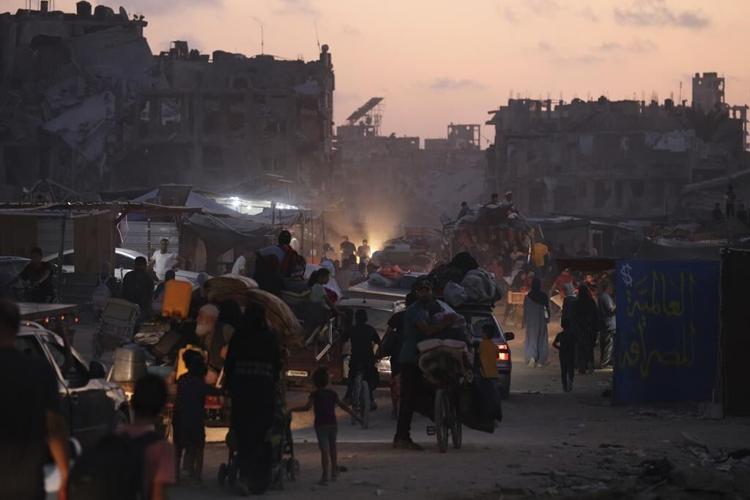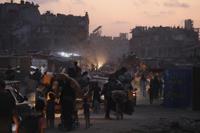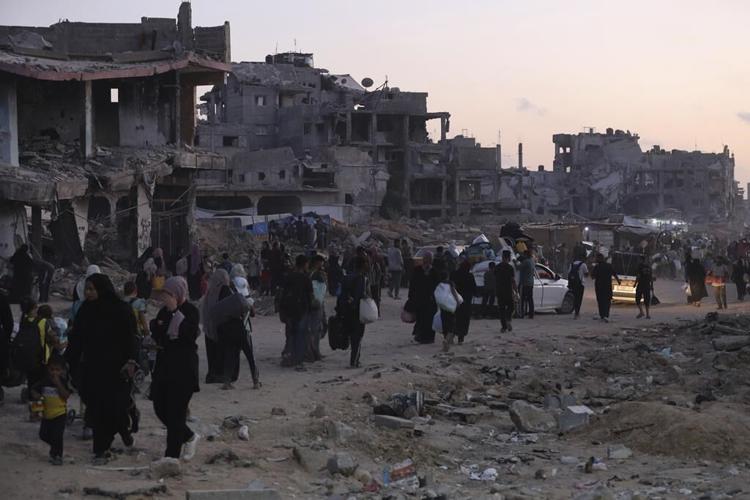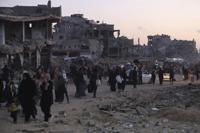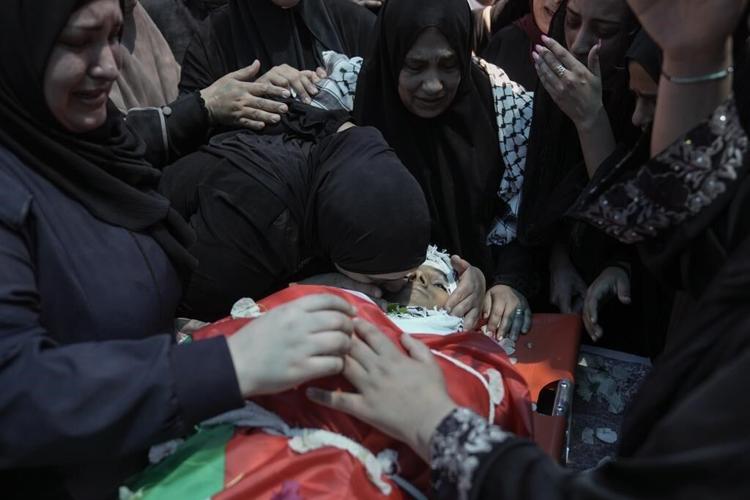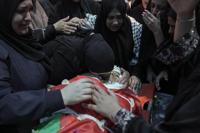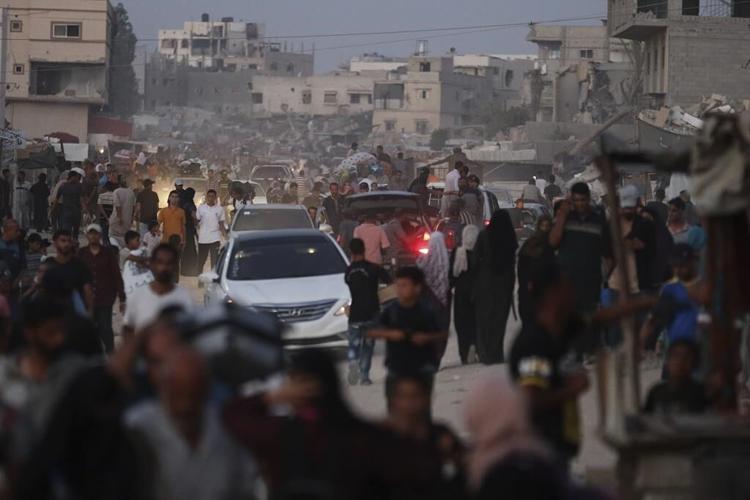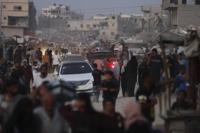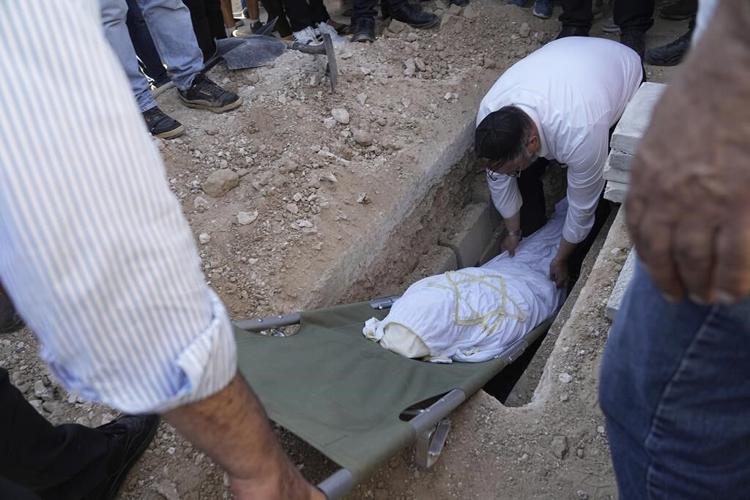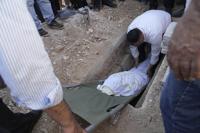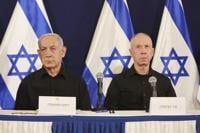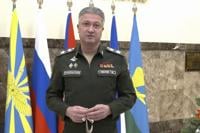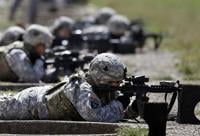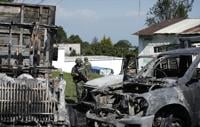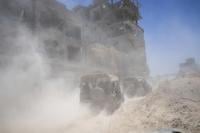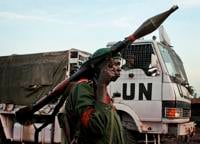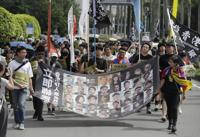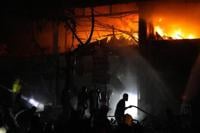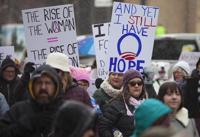Palestinians are streaming out of eastern Khan Younis, the second-largest city in Gaza, as an Israeli evacuation order affects roughly 250,000 people, the United Nations said Tuesday.
Israel’s military estimated that around 1.9 million people — more than 80% of all Palestinians in the Gaza Strip — are now clustered into the territory’s central region.
Although the exact number of people fleeing Khan Younis was not immediately known, Sigrid Kaag, the top U.N. humanitarian official for Gaza, said there are around 1.9 million displaced people in Gaza. She said civilians in the besieged territory have been pushed “into an abyss of suffering.”
Evacuees have been told by Israel to seek refuge in an overcrowded coastal area where there are and which is filled with . The war has largely cut off the flow of to Gaza, and people are totally dependent on humanitarian aid. The top U.N. court has concluded there is a — a charge Israel strongly denies.
On Monday, Israel's military instructed Palestinians to evacuate a wide swath of Khan Younis and nearby areas, and go to the Israeli-declared safe zone. This suggests Israel will launch a new ground assault into the city.
However, an Israeli strike inside the safe zone Tuesday killed , including nine members of the same family. Some of the dead had just fled Khan Younis hours earlier, said Asmaa Salim, a relative who lived in the targeted house in Deir al-Balah. The Israeli military did not immediately comment on the strike.
Israel launched the war in Gaza after , in which militants stormed into southern Israel, killed some 1,200 people — mostly civilians — and abducted about 250.
Since then, Israeli ground offensives and bombardments have killed more than 37,900 people in Gaza, according to the territory's , which does not distinguish between combatants and civilians in its count.
Currently:
— Hezbollah’s deputy leader says the group would after Gaza cease-fire.
— , signaling a likely new assault on the southern Gaza city.
— Turkey’s president after anti-Syrian rioting erupts.
— Lawsuit accuses of providing support for Hamas’ Oct. 7 attack on Israel.
— accuse each other of having no plan or experience ahead of runoff.
— Follow AP’s coverage of the war in Gaza at
Here’s the latest:
Israeli strike kills 4 men in a West Bank refugee camp. Army says they were militants planting explosives
JERUSALEM — Palestinian health officials say four Palestinians were killed by an Israeli airstrike in a refugee camp in the northern West Bank late Tuesday.
Israel’s military said an aircraft struck a group of militants who were planting explosives in the area of Nur Shams, an urban refugee camp near the city of Tulkarem. The camp has been a frequent target of the Israeli forces and is known as a militant stronghold.
Early Wednesday, the Palestinian Health Ministry released the four men’s names and ages, ranging from 20-25 years old. Local news outlets published photos reportedly showing two of the men holding assault rifles and one wearing a combat vest, indicating they were militants. No groups immediately claimed them as members.
Israel has been operating in Nur Shams for the past week. An Israeli soldier was in the camp on Monday, the military said.
Since the Israel-Hamas war, over 550 Palestinians have been killed by Israeli fire in the West Bank, with Israeli raids into Palestinian cities and towns driving up the death toll.
Israel plans to move ahead with over 6,000 new settlement homes in the West Bank, watchdog group says
JERUSALEM — An anti-settlement watchdog group says Israeli authorities are scheduled to approve or advance construction of over 6,000 new settlement homes in the occupied West Bank in the coming days.
If the vote goes through, it could trigger new tensions with the United States at a time when relations between the two allies have been strained by the ongoing Israeli war against Hamas.
Peace Now said the Higher Planning Committee, the defense body responsible for settlement planning, is set to approve the construction at meetings on Wednesday and Thursday. A spokesman for COGAT, the Israeli defense body that oversees the committee, declined to comment.
The United States and most of the international community consider settlements to be illegal or obstacles to peace, and past settlement announcements have drawn angry condemnations from the U.S. Israel’s hard-line government is dominated by West Bank settlers and their allies.
Over 500,000 Israelis live in settlements in the West Bank, in addition to 200,000 settlers in east Jerusalem. The Palestinians seek the West Bank, east Jerusalem and Gaza – areas captured by Israel in the 1967 Mideast war – for an independent state.
‘An abyss of suffering’: U.N. official says aid efforts in Gaza face huge challenges and 1.9 million people are now displaced
UNITED NATIONS — The top U.N. humanitarian official for Gaza says efforts to accelerate and streamline the delivery of humanitarian aid throughout the territory have been “fraught with challenges,” and deliveries have “dropped significantly” since Israel launched its military offensive in the southern city of Rafah on May 6.
More than 1.9 million of Gaza’s 2.3 million people are displaced, Sigrid Kaag told the U.N. Security Council on Tuesday. She said the public health system has collapsed, schools are destroyed, and with summer temperatures soaring and severe shortages of water and sanitation, “the specter of outbreaks of infectious and communicable diseases looms large.”
“There is no substitute for political will, full respect for international humanitarian law, especially the protection of civilians, and a safe and enabling environment to secure effective distribution.” said Kaag, the U.N. senior humanitarian and reconstruction coordinator for Gaza.
She said the war, sparked by Hamas’ surprise invasion of southern Israel on Oct. 7, has plunged Palestinian civilians in the territory “into an abyss of suffering,” creating not only a humanitarian crisis but unleashing “a maelstrom of human misery.”
While Israel has fulfilled some commitments to improve aid deliveries, Kaag said, “Military activity and the lack of safe routes inside Gaza continue to impact humanitarian operations.” She added that, “A near-total breakdown of civil order has further led to an environment of lawlessness and criminality.”
Kaag called for urgent action to establish an effective “deconfliction and coordination system across Gaza,” clear mines from aid routes, daily required fuel deliveries, and deliveries of security and communications equipment, spare parts and critical humanitarian items.
She also called for scaling up aid from Jordan and through the Zikim and Erez crossings, reopening the Rafah crossing and opening additional crossings in the south, and considering moving aid from the north to the south.
Following last week’s evacuation of 21 Palestinian children with serious illnesses from Gaza to Egypt and in view of the immense needs, she asked the council “as a priority” to help establish “a more regular and predictable system of medical evacuations for patients.”
Israeli settlers descend on a Palestinian village in the West Bank again as soldiers watch, residents say
JERUSALEM — Israeli settlers staged yet another incursion into the Palestinian village of Umm al-Khair Tuesday, a Bedouin hamlet in the southern West Bank that has weathered a week of home demolitions and repeated settler attacks.
Two trucks full of Israeli soldiers arrived at the village before the settlers got there, said Eid Suleman, a well-known artist who lives in the village and had his home demolished last week. The soldiers looked on as a group of settlers from a nearby outpost set up a small clubhouse in a tent directly next to a Palestinian home.
“They literally tied the tent’s rope to the house,” said Awdah Hathaleen, a 29-year-old teacher and lifelong resident of the village, which was founded by Palestinians displaced from the Negev Desert in southern Israel during the 1948 war surrounding the country’s creation.
Hathaleen said the settlers spent about two hours in the tent, playing loud music and letting their sheep graze on village land. He said a group of 40 settlers arrived later in the day, standing and praying in the middle of the village.
Israel’s military did not immediately respond to a message from The Associated Press seeking comment on Tuesday’s events.
Last week, Israeli bulldozers demolished several houses in the village, leaving a quarter of its 200 people homeless, including 31 children. The Israeli military body responsible for civilian matters in the West Bank, COGAT, said the demolished structures had been built illegally and without permits. Palestinians in these areas have long said it is virtually impossible to get construction permits from Israeli authorities.
Since the demolition, Hathaleen said the people whose homes were torn down have been sleeping outside.
“We are really broken,” said Hathaleen. “People are starting to think, ‘Where should we go?’”
The demolition was followed by a string of assaults on the village by settlers from a neighboring outpost called “Shorashim Farm,” led by Israeli settler Shimon Atiya.
Settlers arrived in the village Monday and injured six Palestinians, including four women and a 5-year-old girl, with tear gas and sticks. The military described the episode as a “violent confrontation” with rocks hurled by both sides.
“We know what this is. They’re trying to expel us out of here,” said Suleman. “The military did the dirty job last week and now the settlers are following up.”
Israel says 80% of all Palestinians in Gaza are now clustered in the territory’s central region
JERUSALEM — Israel says 80% of all Palestinians in the Gaza Strip are now clustered into the territory’s central region after many were driven out of Rafah by Israel’s military offensive there.
Col. Elad Goren, a senior official in the military body overseeing Palestinian civilian affairs, announced the estimate Tuesday while speaking to reporters. He said recent evacuations from the southern city of Rafah, which began in early May, have led many to take shelter in the center.
Goren said to its self-declared “humanitarian area” along the Gaza’s southwest coast and two urban refugee camps in central Gaza. “From our assessment, there are approximately 1.8, 1.9 million people in this area,” he said.
While Israel calls the area a humanitarian zone, living conditions for those displaced are squalid, United Nations and rights groups say. Many are crowded into tent camps along the beach that lack adequate sanitary or medical facilities, with families .
International law says the Israeli military, as the occupying power, must protect Palestinian civilians. The International Court of Justice has ordered Israel to do all it can to prevent deaths in the besieged enclave and ramp up humanitarian aid.
Around 100,000 Palestinians have left the Gaza Strip since the start of the Israel-Hamas war, Palestinian border officials told The Associated Press, and another 300,000 are in the heavily damaged north, per U.N. estimates.
Some tens of thousands remain in the Rafah area, per U.N. estimates.
The Rafah border crossing with Egypt was the only place Palestinians could leave Gaza, but it has been closed since Israeli forces captured it in early May. Before that, Israel and Egypt had tightly restricted the movement of people out of Gaza. Some Palestinians had been able to get out by using private brokers.
Israel will power a desalination plant in Gaza but water in the territory will remain limited
JERUSALEM — Israel says it will begin to power a major desalination plant in the southern Gaza Strip, a move that Israeli officials say could increase the amount of water produced by the plant.
Israeli Defense Minister Yoav Gallant this week officially approved the plan to run a new power line to the desalination plant in the southern Gaza city of Khan Younis. The plant is a major source of clean water for the hundreds of thousands of Palestinians crowded into the neighboring areas, many of whom were displaced by Israeli evacuation orders.
COGAT, the Israeli military body in charge of humanitarian aid to Gaza, said the plan could quadruple the amount of water the plant is able to produce. Water is scarce in Gaza as summer approaches, with many Palestinians lining up for hours on end for a jug of water to be shared among an entire family. Israeli bombardment has decimated much of Gaza’s water system.
The power line still requires several repairs inside Gaza before it can function, Col. Elad Goren, a senior official in the military body overseeing Palestinian civilian affairs, told reporters Tuesday. He predicted the line would be functional “in a week or two.”
UNICEF, the U.N. agency running the plant, confirmed an agreement had been reached with Israel. The agency said the plan to deliver power to the plant was “an important milestone,” and said it was “very much looking forward to seeing it implemented.”
The move is unlikely to solve the water crisis in Gaza. Even before the war, desalination plants accounted for only a fraction of the potable water in the strip. The territory’s main water source, a coastal aquifer, has been overpumped and almost none of its water is drinkable.
Israel chooses a critic of the International Court of Justice to be its ad hoc judge in the genocide case brought by South Africa
JERUSALEM — Israel has tapped a professor critical of the International Court of Justice to be its ad hoc judge in the case before the court .
On Tuesday, Israeli officials confirmed the appointment of Ron Shapira to replace Aharon Barak, a former chief justice of Israel’s highest court who had served on the panel. Barak stepped down from the ICJ post in June, citing family reasons.
Shapira, the rector of the Peres Academic Center and a former Dean of the Faculty of Law at Bar-Ilan University, has called the court “a body that almost all residents of Israel think is unworthy of any level of trust” on his personal Facebook page, according to reports in Israeli media. Now, Shapira will be part of the panel of judges on that same court charged with adjudicating .
Israel denies South Africa’s allegations, saying it is waging a war of self-defense against Hamas, the Palestinian militant group whose Oct. 7 attack triggered the war.
In May, the court its military offensive in the southern Gaza city of Rafah, an order that Israel has ignored. The court has also ordered Israel to do all it can to prevent deaths in the besieged enclave and ramp up humanitarian aid.
2 Israeli soldiers are killed and a third wounded fighting in central Gaza, military says
JERUSALEM — The Israeli military says two of its soldiers have been killed and a third soldier was severely wounded fighting in central Gaza. It did not provide details of the battle in a statement issued Tuesday.
The Islamic Jihad militant group said it shelled Israeli supply lines Monday in the Netzarim Corridor in central Gaza. The army carved out the corridor, which stretches from the border to the sea, early on in the war to sever northern Gaza from the south.
It was not possible to independently confirm battlefield reports from either side.
The military says 674 soldiers have been killed since the start of the war in Gaza, more than half of them in Hamas’ Oct. 7 attack that triggered the fighting.
At least 9 Palestinians are killed in an Israeli strike overnight in southern Gaza
KHAN YOUNIS, Gaza Strip — Palestinian health officials say an Israeli strike has killed at least nine people in the southern Gaza city of Khan Younis.
The overnight strike came after Israel of parts of the city Monday ahead of a likely ground operation.
Records at Nasser Hospital, where the dead and wounded were taken, show that three children and two women were among those killed. Associated Press reporters at the hospital counted the bodies.
The strike hit a home near the European Hospital, which is inside the zone that Israel said should be evacuated. After the initial evacuation orders, the military said the facility itself was not included, but its director says most patients and medics have already been relocated.
The military said it launched retaliatory strikes after Palestinian militants fired a barrage of some 20 projectiles into Israel from Khan Younis on Monday. There were no reports of casualties or damage from the rocket attack. The main United Nations agency providing aid in Gaza says the latest evacuation orders apply to some 250,000 people, many of whom have already been displaced. That’s more than 10% of Gaza’s population of 2.3 million.
About 250,000 people live in the latest mass-evacuation zone ordered by Israel, UNRWA official says
BEIRUT — A United Nations official says around 250,000 people live in the areas in southern Gaza where Israel .
The Israeli military on Monday ordered new evacuations in and around the city of Khan Younis, which during an offensive earlier in the year. It was the third mass evacuation ordered in less than three months.
Sam Rose, the director of planning at the U.N. agency for Palestinian refugees, known as UNRWA, said Tuesday that the agency believes some 250,000 people are in the evacuation zone — over 10% of Gaza’s population of 2.3 million — including many who have fled earlier fighting. He says another 50,000 people living just outside the zone may also choose to leave because of their proximity to the fighting. Evacuees have been told to seek refuge in a sprawling tent camp along the coast that is already overcrowded and has few basic services.
Issam Shahwan, the director of the European Hospital located within the evacuation zone, said the facility was nearly evacuated, with the last patients and medics awaiting transport to other medical facilities. After issuing the initial evacuation order, the military clarified that the European Hospital did not need to evacuate.
Palestinian militants fired a barrage of around 20 projectiles at Israel from Khan Younis on Monday, without causing any casualties or damage.
Over a million Palestinians fled the southern city of Rafah in May after Israel launched operations there. Israeli forces have repeatedly returned to areas of Gaza where they had previously operated. Palestinians and aid groups say nowhere in the territory feels safe.
Liora Argamani, mother of a freed hostage, dies at 61, less than a month after being reunited with her daughter
JERUSALEM — The mother of a well-known Israeli hostage who was freed from captivity in Gaza in a recent rescue operation has died, the Ichilov Hospital said in a brief statement Tuesday.
Liora Argamani, 61, who had Stage 4 brain cancer, had pleaded for the release of her daughter, Noa, saying she wanted to see her only child before she died.
At the funeral Tuesday, Noa praised her mother, saying “Thank you for being strong and holding on all this time, just so I could see you at least one more time.”
Noa Argamani emerged as an icon of the hostage crisis after a video from the Oct. 7 Hamas attack showed her being forced onto a motorbike and shouting at her captors not to kill her. She in early June in an Israeli military operation in central Gaza. Palestinian health officials said at least 274 Palestinians were killed.
The two were reunited, but Yaakov Argamani, Noa’s father, said Liora was in a “very difficult situation” and barely registered seeing her daughter, Israeli media reported.
Hamas took around 250 hostages in its surprise attack into Israel and is still holding around 120 after most of the rest were released during a cease-fire in November. Around a third of those still held are believed to be dead. Some 1,200 people were killed in the attack. Israel’s ongoing offensive, launched in response, has killed at least 37,900 Palestinians, according to Palestinian health officials, who in their count.

